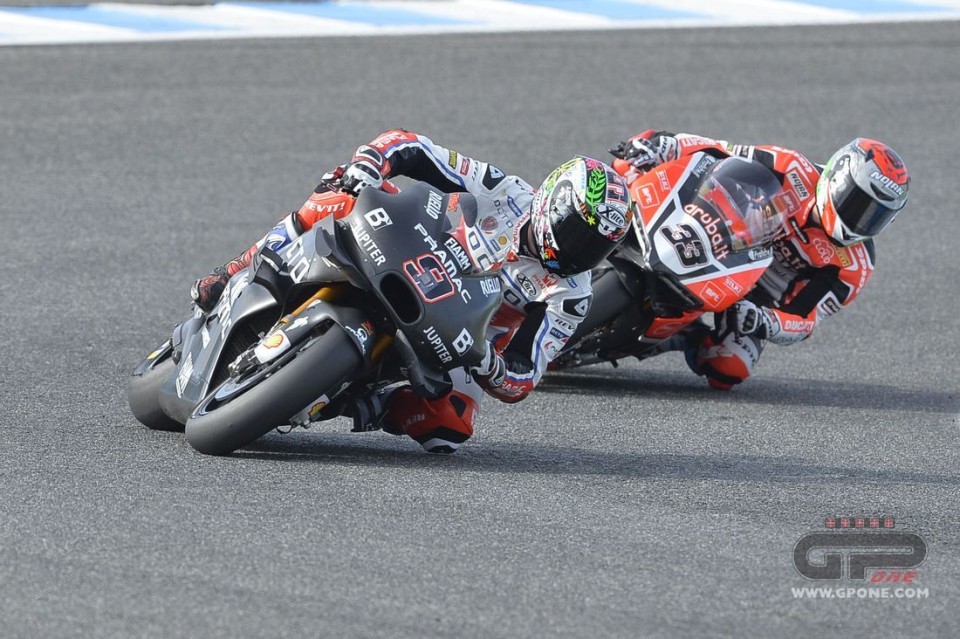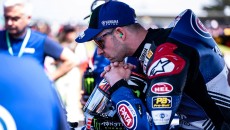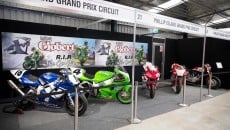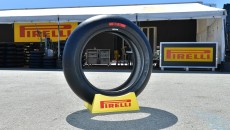The image you see above has not been photomontage. It was taken in November, when some of the MotoGP and SBK riders shared the Jerez track for a test. In fact, on that occasion it made a big stir that the factory derivative riders were ahead of the prototype bikes in the standings.
Let’s just admit it; the virtual comparison between the two worlds is always interesting, although it has no scientific value. It does, however, provide points to ponder, especially in terms of assessing the evolution of the two categories. Phillip Island is one of the tracks that the two championships have in common where, however, the races are held at different times of the year. At the end of the summer for SBK and in the spring for the MotoGP bikes.
And yet, on Saturday some were astonished at Rea’s time, who, with his 1’29”573 would have been on the pole for the last Australian MotoGP race. In truth, Sykes, Melandri, Davies, Lowes and Savadori also did better than Marquez (who did a 1’30”189). To support this type of comparison, however, you must at least have a poor memory. Because the premier class had started qualifying last year at Phillip Island with a damp track which then dried out progressively, so the MotoGP times were recorded with barely acceptable track conditions.
If you really want to find a comparison on the flying laps, it would be better to look at the times of the last Australian tests, one week before the SBK round. The situation is reversed, because in that case, Rea would have been 15th on the timesheets, one second behind Viñales (1'28"549 was the Yamaha-riding Spaniard’s reference time).
It is no surprise that a MotoGP bike is faster than a SBK, but Jonathan’s time is anything but unrespectable. A prototype is an object created for the track with all kinds of technical devilry (pneumatic valves, seamless gearbox, etc.) and investments in the millions. A SBK is still just a factory derivative bike that cannot even count on carbon brakes. It is heavier (168 against 157 Kg) and it costs significantly less. In the end, it defends itself brilliantly. It does, however, have a little “help”: the qualifying tyre, a prerogative of the factory derivatives.
This shows just how much the tyres count and the big difference they can make. For an illustration of this, just look at the fastest laps in the two races. On Saturday Rea did the fast lap at 1’31”197 and on Sunday it was Melandri in 1’31”178. We are talking about a difference of almost a second and a half more than the qualifiers.
Unfortunately, it is impossible to make a comparison because of the weather conditions during the Grand Prix, just to specify for the MotoGP bikes, but we can settle once again for the tests. Looking at Viñales, during a race simulation, his best lap was done at 1’29”000, which is less than half a second slower than his best flying lap.
Races and tests, as we all know, are two worlds apart, but in any case they are useful for showing the biggest differences between the performance of the two types of bikes.
We knew from the start that the SBK machines would be beaten (otherwise, the MotoGP racing departments would have to be shut down post haste…) but the factory derivative bikes, with all of their regulatory limits, still manage to cut a fine figure. In fact, another interesting piece of data comes from the top speeds, and here we can compare the 2016 GP.
On that occasion, Andrea Dovizioso had touched 340.5 Km/h, whereas the fastest SBK rider was Jordi Torres in Race 1 with 319.5. This is also a fairly contained difference if you consider that between a prototype and a factory derivative bike, there is about a 40HP difference, just for the sake of providing data that is not exact, but close enough to reality.
We’ll stop here, in any case bearing in mind that Phillip Island is a circuit with particular characteristics, without demanding braking or acceleration sections, areas where the MotoGP bikes would be able to further exploit their technology.
We have subjected the SBK machines to an unequal comparison, but at the end of the day, they came out with heads held high.









